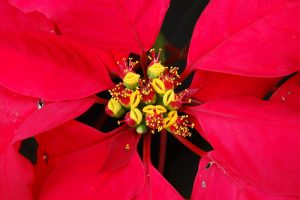The poinsettia, the most popular holiday plant, is best known as the plant with bright red flowers on a green background. But the showiest part of the poinsettia is the group of colorful specialized leaves called floral bracts that surround the small, yellowish-green structures that are the true flowers. Red is still the most popular color, but bracts may also be pink, salmon-colored, yellow, white or multicolor.
The long-lasting nature of today’s poinsettias can only be enjoyed if they receive the proper care in your home. The best way to extend their beauty is to match, as closely as possible, the conditions in which they were produced. Poinsettias are raised in greenhouses where temperatures can be maintained between 65 -75 F with high relative humidity and high light intensity.
These conditions will be difficult, if not impossible, to match in the home. Natural light intensity tends to be quite low and of shorter duration in the winter. And as we heat the air indoors, the air becomes drier so that relative humidity often drops below the level of plant and people comfort.
Make the most of the situation by placing your plant near a sunny window, but do not allow the foliage or flowers to contact cold window glass. Artificial light may be needed for extended growing periods. A humidifier will increase both plant and people comfort. Grouping plants together on a pebble tray will help raise humidity around the plants themselves. Both hot and cold drafts can cause leaf drop, so avoid placing plants near doors or heating vents.
Both under- and over-watering can decrease the life of your plant. Plants that are allowed to wilt will begin to brown along the edges of the leaves and floral bracts or may drop leaves entirely. Watering too often will prevent proper aeration of the soil, and roots will begin to decay. Poinsettias should be watered when the top inch of soil feels dry to the touch. If your pot was wrapped in foil, be sure to poke a few holes through the bottom to allow excess water to drain away.
And if you’re giving a poinsettia as a gift, be sure to protect it from frigid outdoor temperatures during transport. If you make your purchase from a florist or other supplier, be sure they wrap your purchase. Get the plant from the store to your car as quickly as possible. Preheat the car beforehand to prevent further chilling injury. Plants left in an unheated car can be injured or killed quickly, so drop the plants off at home before running other errands.
The poinsettia is sometimes misleadingly listed as a poisonous plant, though it is not particularly toxic. Some people and pets may be sensitive to the plant’s milky sap, resulting in skin irritation when skin is in contact with that sap. It is always best to keep plants out of the reach of children and pets.
More information on the poinsettia can be found at https://hort.purdue.edu/ext/HO-073.pdf.

